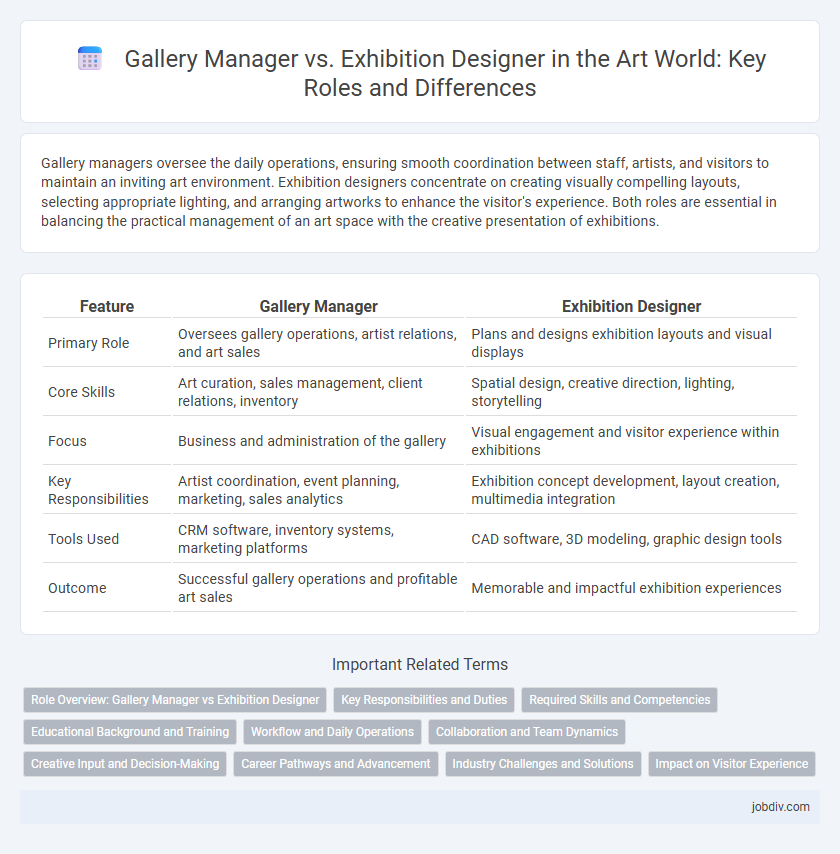Gallery managers oversee the daily operations, ensuring smooth coordination between staff, artists, and visitors to maintain an inviting art environment. Exhibition designers concentrate on creating visually compelling layouts, selecting appropriate lighting, and arranging artworks to enhance the visitor's experience. Both roles are essential in balancing the practical management of an art space with the creative presentation of exhibitions.
Table of Comparison
| Feature | Gallery Manager | Exhibition Designer |
|---|---|---|
| Primary Role | Oversees gallery operations, artist relations, and art sales | Plans and designs exhibition layouts and visual displays |
| Core Skills | Art curation, sales management, client relations, inventory | Spatial design, creative direction, lighting, storytelling |
| Focus | Business and administration of the gallery | Visual engagement and visitor experience within exhibitions |
| Key Responsibilities | Artist coordination, event planning, marketing, sales analytics | Exhibition concept development, layout creation, multimedia integration |
| Tools Used | CRM software, inventory systems, marketing platforms | CAD software, 3D modeling, graphic design tools |
| Outcome | Successful gallery operations and profitable art sales | Memorable and impactful exhibition experiences |
Role Overview: Gallery Manager vs Exhibition Designer
Gallery Managers oversee daily operations, manage staff, handle budgets, and coordinate marketing efforts to ensure the gallery's profitability and smooth functioning. Exhibition Designers specialize in planning and creating the visual layout of exhibitions, focusing on aesthetics, visitor experience, and the effective presentation of artworks. Both roles demand collaboration with artists and curators but differ in their emphasis on operational management versus creative spatial design.
Key Responsibilities and Duties
Gallery Managers oversee daily operations, staff coordination, and visitor engagement to ensure smooth gallery functioning and promotion of exhibitions. Exhibition Designers focus on conceptualizing and designing spatial layouts, lighting, and display elements to create immersive and visually compelling art presentations. Both roles collaborate closely to balance administrative efficiency with creative exhibition execution.
Required Skills and Competencies
A Gallery Manager requires strong organizational skills, proficiency in art curation, and expertise in client relations to oversee daily gallery operations and sales. Exhibition Designers need creative vision, technical knowledge of spatial planning, and proficiency in design software to create engaging and functional art displays. Both roles demand excellent communication skills and a deep understanding of contemporary art trends to ensure successful gallery and exhibition experiences.
Educational Background and Training
Gallery managers typically hold degrees in art history, museum studies, or arts administration, combined with extensive training in curatorial practices and exhibition logistics. Exhibition designers often possess specialized education in design fields such as interior design, architecture, or visual arts, emphasizing spatial planning and creative installation techniques. Both roles demand hands-on experience, with gallery managers focusing on collection stewardship and public programming, while exhibition designers prioritize aesthetic presentation and audience engagement through innovative design solutions.
Workflow and Daily Operations
Gallery Managers oversee the daily operations of art spaces, coordinating staff schedules, managing budgets, and ensuring smooth visitor experiences. Exhibition Designers focus on conceptualizing and implementing display layouts, selecting lighting, and arranging artworks to optimize visual impact and narrative flow. Both roles require collaboration for successful exhibitions, with Gallery Managers handling logistics and Exhibition Designers driving creative presentation.
Collaboration and Team Dynamics
Gallery managers oversee operational aspects and coordinate staff, ensuring smooth daily functions, while exhibition designers focus on the creative presentation and spatial arrangement of artworks. Effective collaboration between gallery managers and exhibition designers enhances visitor experience by balancing logistical feasibility with artistic vision. Successful team dynamics rely on clear communication and mutual respect, allowing both roles to align objectives and deliver cohesive, engaging exhibitions.
Creative Input and Decision-Making
Gallery Managers oversee the strategic planning and operational execution of art exhibitions, ensuring alignment with the institution's vision and audience engagement goals. Exhibition Designers focus on the creative layout and visual storytelling, crafting immersive environments that enhance the viewer's experience and highlight the artworks' thematic elements. Both roles require collaborative decision-making, but Gallery Managers prioritize curatorial and budgetary considerations, while Exhibition Designers emphasize spatial design and aesthetic coherence.
Career Pathways and Advancement
Gallery managers oversee daily operations, artist relations, and exhibition planning, developing skills in leadership, marketing, and art curation that facilitate advancement to senior management or directorship roles. Exhibition designers specialize in creating visually compelling displays, mastering spatial design, lighting, and materials to enhance visitor experience, with career progression leading to senior design positions or roles in museum curation. Both career pathways require strong collaboration with artists and institutions, but gallery managers pivot towards administrative leadership while exhibition designers focus on creative and technical expertise.
Industry Challenges and Solutions
Gallery managers face challenges in inventory control, client relations, and operational logistics, requiring robust management software and data analytics to streamline processes. Exhibition designers encounter obstacles in spatial planning, interactive technology integration, and cohesive storytelling, relying on advanced CAD tools and immersive design techniques to enhance visitor engagement. Collaborative communication platforms bridge the gap between gallery managers and exhibition designers, facilitating timely updates, resource allocation, and unified project execution in the art industry.
Impact on Visitor Experience
Gallery Managers shape the visitor experience by curating accessible art displays and ensuring smooth operations within the gallery space. Exhibition Designers enhance engagement through innovative spatial layouts, lighting, and interactive elements that evoke emotional and intellectual responses. Both roles collaborate to create immersive environments that deepen audience connection with the artwork.
Gallery Manager vs Exhibition Designer Infographic

 jobdiv.com
jobdiv.com